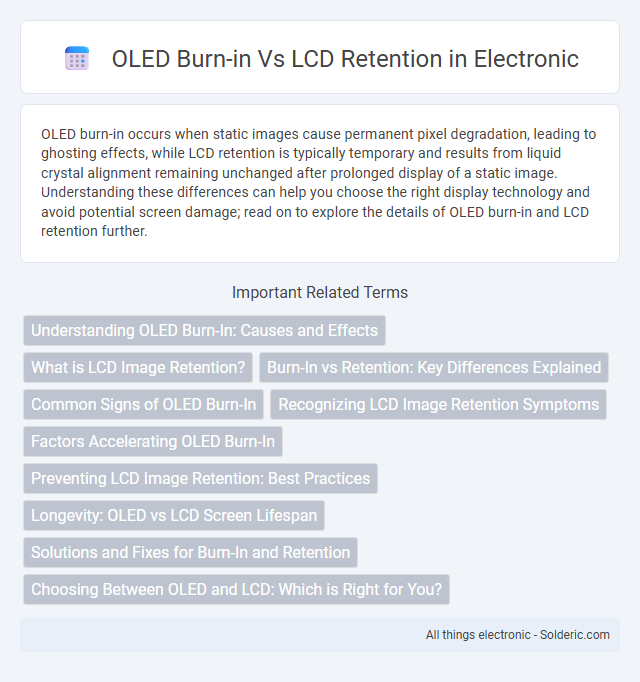OLED burn-in occurs when static images cause permanent pixel degradation, leading to ghosting effects, while LCD retention is typically temporary and results from liquid crystal alignment remaining unchanged after prolonged display of a static image. Understanding these differences can help you choose the right display technology and avoid potential screen damage; read on to explore the details of OLED burn-in and LCD retention further.
Comparison Table
| Feature | OLED Burn-In | LCD Image Retention |
|---|---|---|
| Cause | Organic pixel degradation from static images | Temporary charge buildup in liquid crystals |
| Duration | Permanent damage | Typically temporary, disappears over time |
| Visibility | Visible ghost images, permanent | Faint image ghosting, disappears with usage |
| Prevention | Use screen savers, avoid static content | Avoid prolonged static images, power cycling |
| Repair | No effective repair, may require panel replacement | Usually resolves without intervention |
| Common Devices | OLED TVs, smartphones | LCD monitors, TVs |
Understanding OLED Burn-In: Causes and Effects
OLED burn-in occurs when static images remain on the screen for prolonged periods, causing uneven degradation of organic pixels and resulting in permanent ghost images. This phenomenon is due to the organic compounds in OLED displays aging at different rates, especially in areas with high brightness or contrast. Unlike LCD retention, which is typically temporary and caused by liquid crystal alignment issues, OLED burn-in leads to irreversible damage affecting display quality.
What is LCD Image Retention?
LCD image retention occurs when a static image displayed for a prolonged period temporarily remains visible on the screen, caused by the liquid crystals not returning to their neutral state immediately. Unlike OLED burn-in, which results from organic material degradation leading to permanent ghosting, LCD image retention is typically reversible once the display shows varying content. This phenomenon often appears as faint shadows or ghost images and is more common in LCD panels using IPS or VA technology.
Burn-In vs Retention: Key Differences Explained
OLED burn-in occurs when static images cause permanent pixel degradation, leading to ghost images on the screen, whereas LCD retention is temporary image persistence caused by liquid crystal alignment issues that generally resolves over time. OLED burn-in results from organic material aging unevenly under prolonged static display, while LCD retention arises from charge buildup in the liquid crystals affecting pixel state temporarily. Understanding these distinctions highlights OLED's vulnerability to permanent damage versus the typically reversible nature of LCD retention.
Common Signs of OLED Burn-In
Common signs of OLED burn-in include persistent ghost images or uneven discoloration on the screen, especially noticeable in static areas like navigation bars and logos. This long-term image retention results from organic materials in OLED pixels degrading at different rates due to prolonged exposure to static visuals. Your device may exhibit reduced brightness or color accuracy in affected areas, distinguishing burn-in from temporary LCD image retention that usually fades quickly.
Recognizing LCD Image Retention Symptoms
LCD image retention appears as faint, ghost-like afterimages caused by prolonged static content, which differs from permanent OLED burn-in due to its typically temporary nature. Recognizing symptoms includes noticing subtle shadows or outlines lingering after changing the displayed content, especially in high-contrast areas or on bright backgrounds. Understanding these signs helps you differentiate between temporary retention and permanent damage, ensuring appropriate screen maintenance or adjustments.
Factors Accelerating OLED Burn-In
OLED burn-in accelerates due to prolonged display of static images, high brightness settings, and uneven pixel usage, causing organic compounds to degrade at different rates. Factors such as blue OLED materials aging faster than red or green layers contribute to color shifts and image retention. Extended exposure to intense light and inconsistent screen elements increase the risk of permanent burn-in compared to LCD retention, which is typically temporary and less severe.
Preventing LCD Image Retention: Best Practices
Preventing LCD image retention involves regularly changing screen content and using screen savers to avoid static images that cause temporary ghosting. Lowering brightness and enabling pixel shift or screen refresh features can reduce stress on LCD pixels and minimize retention risk. Regularly powering off the display and avoiding prolonged display of static elements enhances long-term screen health.
Longevity: OLED vs LCD Screen Lifespan
OLED screens typically have a shorter lifespan than LCDs due to organic material degradation that causes burn-in and reduced brightness over time. In contrast, LCD screens generally offer longer longevity as they rely on backlighting and do not suffer from burn-in, though image retention can occur temporarily. LCD panels often maintain consistent brightness and color accuracy for a more extended period compared to OLED displays, making them more durable in long-term usage.
Solutions and Fixes for Burn-In and Retention
OLED burn-in can be mitigated by using pixel-shifting, screen savers, and adjusting brightness levels to reduce static image exposure. For LCD retention, enabling pixel refresh functions and avoiding prolonged static content display are effective solutions. Using varied content and software that detects and corrects retention issues also helps extend display lifespan and maintain image quality.
Choosing Between OLED and LCD: Which is Right for You?
OLED screens offer exceptional contrast and vibrant colors but are susceptible to burn-in, where static images can cause permanent ghosting over time. LCD displays avoid burn-in issues due to their backlit technology, though they may experience temporary image retention that usually resolves with varied content. Choosing between OLED and LCD depends on your usage patterns: OLED is ideal for multimedia and gaming with dynamic visuals, while LCD suits environments with static content, minimizing screen degradation risks.
OLED burn-in vs LCD retention Infographic

 solderic.com
solderic.com